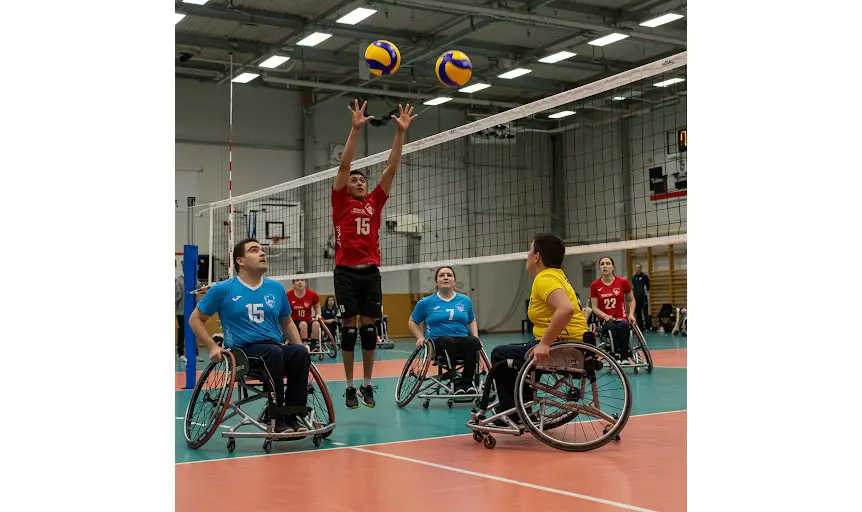
Paralympic Volleyball: A Global Force of Inclusion and Excellence
Paralympic Volleyball stands as one of the most inspiring and competitive adaptive sports in the world. Athletes demonstrate unmatched resilience, skill, and teamwork in this dynamic game. The sport has evolved significantly since its inception, gaining global traction across continents. From grassroots programs to elite international tournaments, Paralympic Volleyball reflects progress, empowerment, and social change. In this post, we will explore the sport’s origin, global presence, amateur involvement, professional leagues, social impact, and rules.
The Origin and History of Paralympic Volleyball
The history of Paralympic Volleyball begins after World War II. Many soldiers returned with injuries, and adaptive sports offered them a path to recovery and integration. In 1956, a new variation of volleyball known as “Sitzball” emerged in Germany. It involved sitting on the floor and using standard volleyball rules with adaptations.
By the 1960s, sitting volleyball evolved from Sitzball. Dutch sports therapists played a significant role in its development. In 1967, the Netherlands officially introduced sitting volleyball as a competitive sport for people with physical impairments. Just over a decade later, in 1980, it made its debut at the Paralympic Games in Arnhem, Netherlands.
Since then, the sport has undergone multiple changes. Rules were standardized, and international governance emerged. World ParaVolley, the sport’s governing body, now manages international competitions and helps expand the sport.
Global Popularity and Participation
Paralympic Volleyball enjoys popularity in numerous countries. Nations like Iran, Bosnia and Herzegovina, Brazil, and the USA dominate the sport. Iran’s men’s team, in particular, has become a global powerhouse. The team has won multiple gold medals at the Paralympics.
In Europe, countries like Germany, Ukraine, and the Netherlands have competitive teams. Africa and Asia have also seen growth in recent years, with countries like Egypt and China investing in development programs.
Various global tournaments fuel interest. The Paralympic Games, World Championships, and regional qualifiers attract attention. These events bring visibility and inspire new generations to participate. Social media and streaming services have helped boost viewership.
Amateur Paralympic Volleyball: Youth and School Programs
Amateur participation forms the backbone of the sport. Many nations have youth development programs tailored to sitting volleyball. Schools for children with disabilities often introduce the sport in physical education.
In the United States, organizations like USA Volleyball offer sitting volleyball camps for young athletes. Similarly, the UK’s Sitting Volleyball program partners with schools to provide training sessions and workshops. These programs emphasize inclusion, fitness, and skill development.
NGOs and local sports foundations also contribute. They host community tournaments, offer coaching clinics, and promote awareness. Events like “Paravolley Days” attract children and parents, making the sport more visible.
University-level competitions further enhance skill-building. Student-athletes get access to better training, facilities, and competition. This pipeline prepares top players for national team selection.
Professional Leagues and International Competition
Though still growing, professional sitting volleyball leagues exist in several countries. Iran and Bosnia and Herzegovina have semi-professional clubs with strong fan bases. Club championships in Europe and Asia provide competitive opportunities outside national teams.
In Europe, the European Sitting Volleyball Championship attracts top clubs. These matches feature high-caliber athletes and are often televised. Germany, Russia, and the Netherlands boast some of the strongest clubs in the league.
Asian countries are following suit. Japan, China, and Iran have active domestic leagues. These leagues focus on nurturing talent and preparing athletes for international competition.
North America is making strides. Canada and the USA have regional leagues and inter-state tournaments. These competitions raise the level of play and foster community.
The World ParaVolley Club World Championships also bring together elite clubs. Held every two years, this event showcases the highest level of club play globally.
Political and Social Significance
Paralympic Volleyball is more than a sport; it’s a symbol of equality and empowerment. It challenges stereotypes about disability and promotes social inclusion. Athletes serve as role models, proving that limitations don’t define ability.
Governments and NGOs use the sport to promote disability rights. For example, Iran’s investment in the sport has led to greater awareness and policy shifts. The success of their national team has inspired broader social change.
Women’s sitting volleyball has also made strides. More countries are fielding women’s teams, thanks to targeted programs and advocacy. This progress promotes gender equality within adaptive sports.
In conflict zones, the sport plays a healing role. Bosnia and Herzegovina used volleyball to unite communities after the war. It brought together people from different ethnic backgrounds, fostering peace and reconciliation.
International competitions often highlight these narratives. They provide platforms where athletes share stories and influence public perception. Such events contribute to the global disability movement.
Rules and Gameplay of Paralympic Volleyball
Paralympic Volleyball consists of two primary formats: sitting and standing volleyball. However, only sitting volleyball is currently part of the Paralympic Games.
Sitting volleyball follows most of the traditional volleyball rules with key adaptations. Players must maintain contact with the floor while playing the ball. This rule ensures fairness and challenges athletes’ core strength and agility.
The court measures 10 meters by 6 meters, slightly smaller than a standard court. The net height is 1.15 meters for men and 1.05 meters for women.
Each team has six players on the court. Matches are best-of-five sets. The first four sets go to 25 points, while the fifth set, if needed, goes to 15. Teams must win by two points.
Blocking, spiking, and serving are all allowed. However, players must not lift off the ground. Referees watch for violations closely. Foot faults, illegal lifts, and net touches are penalized.
Classifications ensure fair competition. Athletes must have a qualifying physical impairment. A medical panel evaluates each player before tournaments. Teams can have both minimally disabled and fully disabled players, but only one minimally disabled player may be on the court at a time.
Time-outs, substitutions, and rotations follow traditional volleyball patterns. Strategy plays a huge role. Teams employ quick sets, powerful serves, and tactical blocks to gain an advantage.
Conclusion
Paralympic Volleyball represents more than athleticism. It stands for inclusion, determination, and unity. The sport’s history reflects decades of innovation and resilience. Its global popularity proves its appeal across cultures and continents.
Amateur programs ensure a strong foundation, nurturing young talent worldwide. Professional leagues and international tournaments elevate the sport’s profile. Political and social significance makes it a powerful tool for advocacy and change.
With its unique rules and thrilling gameplay, Paralympic Volleyball captures the hearts of fans and players alike. As it continues to grow, it brings people together, breaks barriers, and inspires the world.





